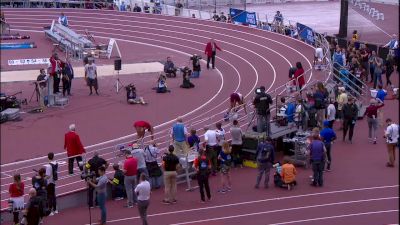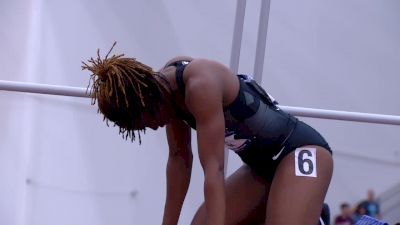After A Record-Setting 2018, What Does The NCAA Have In Store For 2019?
After A Record-Setting 2018, What Does The NCAA Have In Store For 2019?
The 2018 NCAA season was chock full of superstars and record-setting performances. Can 2019 possibly live up?

Before the men’s 4x400m relay at the 2018 NCAA Indoor Championships, Florida coach Mike Holloway had a prediction for USC coach Caryl Smith Gilbert. “I told her before the race you guys are going to run three flat, and we are going to try and go with you,” Holloway said.
Her response?
“She laughed at me.”
Given history, you could understand Smith Gilbert’s skepticism. A time under 3:01 would be the fastest time ever recorded, almost a second clear of the 3:01.77 that Poland established as the world record a week earlier.
But there was also a reason for Holloway’s optimism.
For the last two hours, the meet churned out an endless stream of records and all-time performances. One-upmanship was embedded in the surface of indoor track at Texas A&M.
Prior to the men’s 4x400m, which was expected to be a three-way battle between Holloway’s Gators, USC and Texas A&M, there had already been five collegiate records, three American records, two U20 records and one world record. It was a dizzying display of fast running. Historic times were run in one heat, only to be outdone minutes later. Headlines were written and then rewritten.
Because of this, the idea that it would take a world record to win the final men’s event of the day wasn’t outlandish. Smith Gilbert’s team proved Holloway correct. The Trojans ran 3:00.77 to better Texas A&M’s 3:01:39 and Florida’s 3:01.43. It was the three fastest times ever recorded in the event.
“We ran 3:01.4 and got third, it’s like, ‘who cares, we ran 3:01.4,’” Holloway said.
On this day, and in this season, being one of the best all-time sometimes wasn’t enough to win. Holloway’s Florida team in the 4x400m was just one example, but there were plenty of others.
In the women’s 200m, San Diego State’s Ashley Henderson ran 22.41, .01 off the collegiate record. But in the very next heat, Harvard’s Gabrielle Thomas posted a 22.38 to win the event and get the collegiate record.
Sydney McLaughlin’s world junior record of 50.36 was the second-best NCAA 400m run in history and yet it was still .02 slower than Kendall Ellis’ 50.34.
In the men’s 400m, Akeem Bloomfield’s 44.86 looked like it might stand as the winner of the event from heat one until Michael Norman of USC dropped a 44.52 to break the world record.
“For me, that was top to bottom the best meet I’ve ever seen,” Holloway said.

After a year like that, it’s reasonable to ask if 2018 was an outlier--the combination of an exceptional group of athletes, high-quality competition and a fast surface--or if yearly recycling of the record book will be part of the new routine.
LSU coach Dennis Shaver traces the 2018 explosion back to 2017. During that season, Fred Kerley ran 43.70 in the 400m to set the collegiate record and Christian Coleman broke NCAA records in both the 60m and 100m. Kerley’s mark was such an improvement on the existing record (Quincy Watts’ 44.00 from 1992) that there was an assumption that it would last more than a single year. A similar conclusion can be drawn this year. Norman’s 43.61 from outdoors looks otherworldly, but it too could fall victim to the regenerative power of the NCAA system.
But even by the standards of the NCAA system, 2018 was special.
McLaughlin, Norman and 400m hurdler Rai Benjamin are generational talents, all with the ability to win gold at this year’s IAAF World Championships. That trio went pro this summer. In total, 12 of the 13 individuals who broke collegiate records in 2018 turned pro or exhausted their eligibility.
“Replacing Michael Norman is like replacing Aleia Hobbs, it’s not easy. You’re not going to find those people and come in and make those consistent, big-time performances,” Shaver said.
Hobbs, who starred for Shaver at LSU, tied the collegiate record indoors in the 60m, posted the second, third and fourth fastest collegiate times in the 100m and was part of LSU’s record-setting 4x100m relay team.

Those three aren’t enough to duplicate last year and the slower track conditions at this year’s indoor championships in Birmingham, Ala., should make it hard to pop a fast one at the peak of the indoor season.
But there is also the unknown and the belief that just when a lull looks imminent, somebody new in the NCAA steps in. Even that men’s 4x400m record is vulnerable according to several coaches. McLaughlin’s success was predictable, but Norman’s world record came after competing in just one indoor meet. Benjamin went from NCAA runner-up in 2017, to one of the greatest 400m hurdles in history by 2018.
“I believe we are going to be talking about that group (the 2018 class) in years to come, but with the coaching that is going on nowadays and with opportunities that are created for these kids and the level of competition it’s just really hard to say. Because at the beginning of last year who would have thought it was going to turn out that way,” Shaver said.